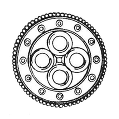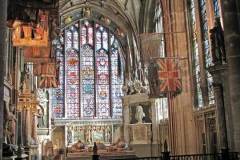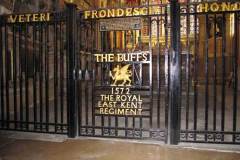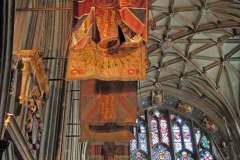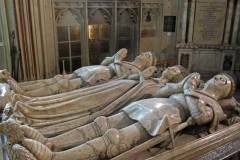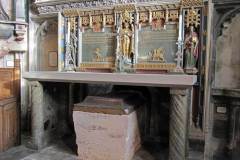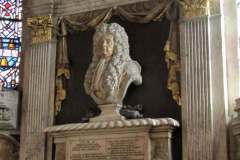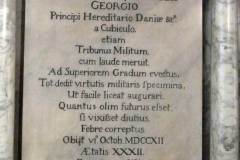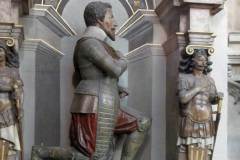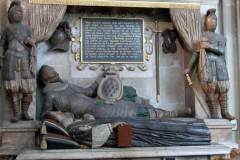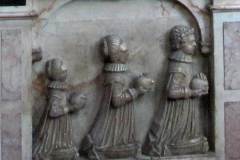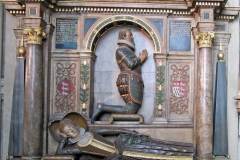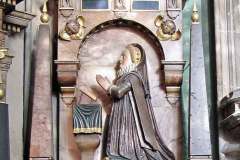This chapel, also known as St Michael’s or the Buff’s chapel, or the Holland chapel, is built off the south west transept. It has strong historical links to the Royal East Kent Regiment, often referred to as the Buffs. The original Norman chapel was rebuilt in 1439 to provide a suitable resting place for Lady Margaret Holland and her husbands (more below). There is normally no public access to the chapel but much of the splendour within can be seen from the chapel gates. The principal features are outlined below.
What to see:
- in the overview from the south west transept (Image 1) you cannot miss the very large triple tomb in the centre (to the wealthy and influential Lady Margaret Holland and husbands), the large collection of regimental flags, the east window and the lierne vaulted ceiling (more below on each of these)
- the chapel gates (Image 2) remind visitors of the links between the city, the cathedral and the Buffs – the Latin motto across the top of the gate “Veteri Frondescit Honore” can be translated as “Its Ancient Honour Flourishes”; the east window (visible in Image 1) replaced the ‘Crimea window’ which was destroyed by enemy action in World War II – the arms of colonels of the Buffs since 1665 are represented in the window and surrounding stone shields
- the north wall provides an impressive display of regimental flags (Image 3); known as regimental ‘colours’, these carry upon them past battle honours and are regarded as the soul of the regiment, to be treated with enormous respect – even when replaced as too worn or damaged they are seen as the embodiment of regimental honour and treated with great reverence – they are not ‘cleaned up’ as they can include dust and dirt from battle fields across the world
- The large central tomb (Image 4) consists of a Purbeck marble chest topped with three alabaster figures – Lady Margaret Holland (died 1439), granddaughter of the Fair Maid of Kent, lies with successive husbands John Beaufort Earl of Somerset (died 1410) on her left and Thomas Duke of Clarence, grandson of John of Gaunt (died 1421) on her right. Margaret died only 11 days after completion of the chapel, and, in line with her wishes, the remains of both husbands, then elsewhere in the cathedral, were reburied beside her.
- The tomb of Archbishop Stephen Langton (Image 5) is not visible from the chapel gate but must be one of the oddest in the cathedral. Langton (died 1228) was buried in the chapel prior to its rebuilding but, later, to make room for the Holland tomb, was moved to a position where he now lies with his head inside the wall but his feet sticking out beyond the chapel external wall. Langton had made important contributions to the church (he gave the bible its chapter and verse numbers) and state (he assisted in the drawing up of Magna Carta), so he surely deserved better treatment!
- at the south east corner of the chapel stands the heavily bewigged bust of Admiral Sir George Rooke (Image 6) (died in 1708 and buried in St Paul’s church Canterbury) – he achieved fame through the capture of Gibraltar for England in 1703
- Brigadier Francis Godfrey (died 1712) has a memorial in Latin in the south west corner of the chapel (Image 7) – he served as ‘groom of the bed chamber of Prince George of Denmark’ and the lower section of the memorial (not visible in Image 7) shows a striking hour glass and a skull, each in green garlands
- on the north wall, Lt Colonel William Prude in armour kneels on one knee on cushion (Image 8) – he had local connections (married Mary Spraklinge at St Paul’s Canterbury in 1606 and had 7 children with her) and was killed at the siege of Mastricht July 1632
- also on the north wall, Thomas Thornhurst lies recumbent on one elbow, his helmet, sword and gauntlets on the wall above (Image 9) – he died during the English (unsuccessful) invasion of the French Isle de Ré (1627); beside him lies his wife Dame Barbara (died 1639), her head resting on a double cushion and her hand on a book
- below Thomas and Barbara we find images of their three young children, each carrying a skull (Image 10)
- the next memorial on the north wall, moving east (Image 11), shows the kneeling figure of Sir Stephen Baker of Sissinghurst (died 1616), third husband of Mary, Lady Thornhurst – note his large neck ruff, small wrist ruffs, leg armour and padded trunks – below him lies his wife Lady Thornhurst, in what has been called the ‘toothache’ attitude (hand on cheek) wearing a ruff at her neck, stomacher, tightly fitting bodice, her hips clearly extended by farthingales, her wrists showing six-buttoned turn-back cuffs – she died in 1609; weepers below – now sadly headless – are their two daughters ‘The Lady Grisogone Lenerd and the Lady Cicely Blunt’
- the third and final Thornhurst monument is to Dame Dorothy Thornhurst (died 1620) who kneels at prayer, sandwiched between two cherubim and obelisks (image 12)
An intricate wall memorial to Sir James Hales once hung here, but was removed to the north aisle of the nave.
Sources: Bell (2009); Church (1910); Cowper (1897); Fricker (1991); Hasted (1800)
DL
